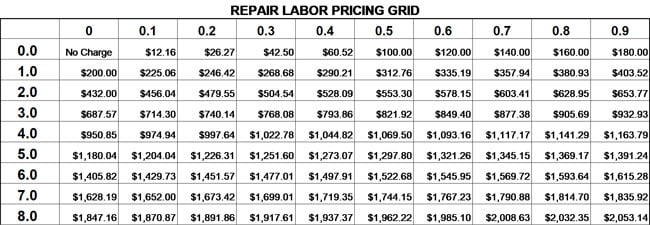Oftentimes, I hear from retailers that their overall ELR has been dropping, and they don’t understand why. When asked this question, I often will begin by asking what their work mix looks like. Rarely do I get a clear answer. Effective labor rates are not overly complicated. Sales dollars divided by hours sold equals the effective labor rate. The overall effective labor rate means very little to me. The question is always—what is your repair effective rate, your maintenance effective rate, and your competitive effective rate? My next question is what is your work mix percentage based on these three metrics? Let’s take a look.
Repair Effective Labor rate is the dollar amount per hour you charge for the technical and highly skilled labor in your shop. Repair work is often work that a skilled and certified technician needs to perform. These technicians are paid the highest rates and normally have the most experience. We have every right to bill a higher price for these repairs. Often retailers know we may, for example, charge $200 per hour for these repairs and just assume this should be the overall effective rate. Not so… there is a mix of work in the shop. We wouldn’t want to bill $200 per hour to change a customer’s oil or change their tires, correct? If you’re a shop that charges a higher flat rate for all of your work, I can guarantee you are losing business. Also, not every labor operation in this repair category will be billed at your full repair rate. There may be a diagnosis fee of $100 per hour or a bulb replacement at $60 per hour. Major repairs to the engine would be at $200 per hour. ELR averages in repair may be 80 percent or so of your posted rate depending on the frequency of lower repair pricing. In many shops, I recommend a labor matrix. A labor matrix is similar to a parts matrix where you begin at your shop rate and move up in a bell curve manner topping out in the 3–6-hour range. This will help with repair ELR and will allow you to retain more gross per hour for the highly skilled jobs.
Sample Matrix:

Maintenance and Competitive Rates
We normally charge a lower rate for Maintenance and Competitive services. Being competitive in our market is important for obvious reasons. It is very important that these items are price-shopped and adjusted at least every six months. Many times, we can command a higher rate for certain services, but we don’t take the time to shop them and make adjustments. If my market is getting, for example, $130 for a brake fluid exchange, and I am billing $113, why not adjust my labor pricing? Even a dollar or two per service can make a huge difference to services we do a lot of. I never say we need to be the cheapest; I always say we need to be competitive in our market.
Managing our pricing and inspecting what our people are billing and how they are discounting already competitive services can greatly increase gross profits. We must work diligently to make sure we are billing fairly but not allowing erosion to our bottom line.
